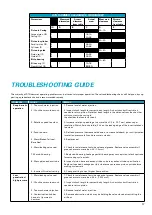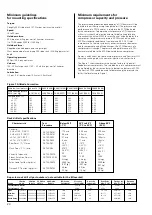
19
PROBLEM
CAUSE
REMEDY
Component
failures
2. Piston struck end cupping
3. Cracked casing
4. Rolled over chuck
5. Cracked backhead-body
6. Cracked backhead
2a. Usually a sign of underfeeding. Increase feed or breaking. until rotation
pressure pulses and then back down till smooth.
2b. Cavitation from excess water injection can cause small pits in piston face.
These pits turn into cracks. Avoid excessive water injection.
3a. Hammering, welding and wrenching in wrong location can fail casings; avoid
these practices and use sharp tong jaws to loosen connections.
3b. Corrosion from internal undercuts and threads;
use good quality (neutral pH) water and flush with oil when finished drilling.
If possible, coat threaded areas undercuts and bore of casing with corrosion
protector such as LPS Hardcoat.
3c. Look for beat in chuck which could allow the piston to stroke far enough to
contact air distributor and overstress the casing. Replace chuck if worn more than
specification.
3d. Look for leaking or loose fitting large diameter valve seal which could make
piston stroke too far and contact distributor. Replace the valve assembly.
3e. Casing has worn beyond discard point. Measure casing OD about 2 in. (50.8
mm) from chuck end. Compare to specification and replace if needed.
3f. Backhead or chuck thread loose. Be sure threaded joints are tight. Do not
reverse rotate or allow hammer to cycle without rotation.
4. Underfeeding can cause the bit to rebound into chuck shoulder. This will
generate a rolled up edge. Increase feed force.
5. Fighting from hole and pulling backhead through caved-in materials creates
frictional heat. Rotate slowly and/or flood with water when stuck.
6. Look for evidence of connection moving on threaded
shoulders. Connection shoulder may be worn allowing movement. Replace/repair
adapter sub or rod.
Breaking
exhaust tubes
1. Erosion
2. Damage
3. Bit tube bore small
1a. Water jetting erodes base of bit tube at striking surface. Reduce level of water
injection.
1b. Contaminants in water mix and cause abrasive blast at base of exhaust tube.
Use clean water.
2a. Damaging tubes when changing bits. Be careful to thread casing onto chuck
while vertical and in alignment.
2b. Use care when transporting bits to avoid damage to tube.
Keep bit in box until needed.
3. The tube bore of a bit can become deformed and pinch the tube. Look for a
rolled over edge or deformation at the top of the bit bore. Remove by grinding
away lip.
Chuck
loosening in
hole
1. Running loose
2. Improper make up torque
1a. Refer to proper feed settings (Section 1)
1b. Avoid feathering feed in loose ground or at end of rod.
2. Tong chuck tight before drilling.
Cylinder
Tangs broken
1. Tail Seal failure
2. Corrosion
1. Replace Tail Seal
2a. Be sure hammer parts have a good coating of oil.
2b. Clean and oil hammer after drilling with foam.
2c. Use non-acidic injection water.






































